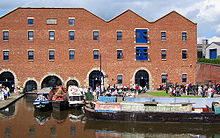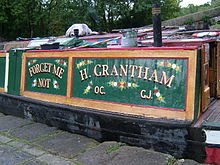- Dukinfield Junction
-
For the geological feature in Washington State, US, see Portland Basin (geology).
Dukinfield Junction (grid reference SJ933984) is the name of the canal junction where the Peak Forest Canal terminates and meets the Ashton Canal near Ashton-under-Lyne, Greater Manchester, England. The area has been designated by Tameside Metropolitan Borough Council as a conservation area.[1]
It is adjacent to Portland Basin, and the names are often used as synonyms by boaters, whilst locals refer only to Portland Basin. Strictly speaking, Portland Basin is the wide area on the main line of the canal. The arm under the junction bridge, and the Tame aqueduct are part of the Ashton Canal, and the junction between the two canals occurs immediately at the southern end of the aqueduct.
Contents
Ashton Canal Warehouse
The Ashton Canal Warehouse was built at the Portland Basin in 1834 by the canal company replacing the early warehouse to the east. It is a three storey warehouse 61 metres (200 ft) by 22 metres (72 ft), brick built in English garden wall bond. The wooden floors are supported by cast iron columns. The southern elevation which opened to the canal was 3 storeys high and it had three shipping holes. The northern elevation which opens to the road is two storeys high, trap doors allowed split loading and unloading between the road and the 3 canal arms. The roof was flat allowing increased storage. The internal hoist system was powereed by an external waterwheel. The head race was taken from the canal, and the tailrace fed down to the River Tame 10m below. The breastshot waterwheel was constructed in 1841 to a suspension design introduced by Thomas Hewes and William Fairburn had rim gearing. It cost ₤1078. It was 24 feet (7.3 m) in diameter and 3 feet (0.91 m) in width and produced 15 hp. Power was transmitted by a line shaft[2]. The building we see today is the result of a 1998 restoration.[3].
Portland Basin Museum
Portland Basin is the location of the Portland Basin Museum, housed within the restored nineteenth century Ashton Canal Warehouse, covering the area's industrial heritage.[4] Exhibits include local history, industry, trades, a 1920s period street with shops, period room displays and historic machines.
Wooden Canal Boat Society
The Portland Basin hosts the Wooden Canal Boat Society which has restored and works six traditional narrowboats. They are a registered charity.
See also
References
- Notes
- ^ Tameside Metropolitan Borough Council. "Appendix 6: Conservation Areas and Scheduled Ancient Monuments (Policies C11 and C30)". Tameside.gov.uk. http://www.tameside.gov.uk/udp/udp1996/appendix6. Retrieved 2008-02-02.
- ^ Nevell & Walker 2001, p. 18
- ^ NcNeil, Nevell & 2000, p. 59
- ^ "Portland Basin Museum". Borough of Tameside. http://www.tameside.gov.uk/museumsgalleries/portland. Retrieved 2009-05-07.
- Bibliography
- McNeil, R.; Nevell (2000). A Guide to the Industrial Archaeology of Greater Manchester. Association for Industrial Archaeology. ISBN 0-9528930-3-7
- Nevell, Mike; Walker (2001). Portland Basin and the archaeology of the Canal Warehouse. Tameside Metropolitan Borough with University of Manchester Archaeological Unit. ISBN 1-871324-25-4
External links
- Portland Basin Museum - official site
Coordinates: 53°28′57″N 2°05′59″W / 53.4826°N 2.0997°W
Categories:- Canal junctions in England
- Canals in Tameside
- United Kingdom canal stubs
Wikimedia Foundation. 2010.



